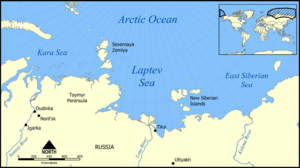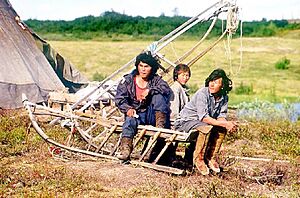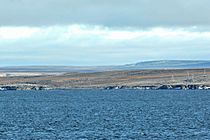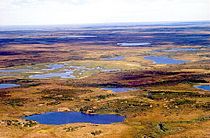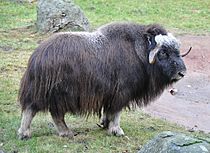Taymyr Peninsula facts for kids
The Taymyr Peninsula (Russian: Таймырский полуостров, romanized: Taymyrsky poluostrov) is a huge piece of land in the Far North of Russia. It is the most northern part of the mainland of Eurasia, which is the combined continent of Europe and Asia. This peninsula is part of the Krasnoyarsk Krai region in Russia.
Contents
Geography of Taymyr
The Taymyr Peninsula sits between two large bodies of water. To its west is the Yenisei Gulf of the Kara Sea. To its east is the Khatanga Gulf of the Laptev Sea.
Inside this vast peninsula, you can find Lake Taymyr and the Byrranga Mountains. The very tip of the Taymyr Peninsula is called Cape Chelyuskin. This cape is the northernmost point of the entire Afro-Eurasian continent.
People of Taymyr
The Taymyr Peninsula is home to several indigenous groups. The Nenets people, sometimes called Samoyeds, are one of these groups. They live in the northern arctic parts of Russia.
Another group is the Nganasan people. They are also a Samoyedic people who live in central Siberia, including the Taymyr Peninsula. The Russian government recognizes them as one of the Indigenous peoples of the Russian North. Most Nganasan people live in small settlements like Ust-Avam, Volachanka, and Novaya. Some also live in the towns of Dudinka and Norilsk. Because they live in such isolated places, the Nganasan people were able to keep their traditional shamanistic practices even into the 1900s.
Economy and Industry
A big company called MMC Norilsk Nickel operates in the Taymyr area. They dig for valuable metals like nickel. The company also has smelting factories near the city of Norilsk, which is close to the peninsula.
The nickel ore and other products are moved by a short railroad to Dudinka. Dudinka is a port city on the Yenisei River. From there, the products are loaded onto boats and shipped to places like Murmansk and other ports.
Wildlife and Ecology
The Taymyr Peninsula was once home to muskoxen, which are large, shaggy Arctic mammals. However, the last naturally living muskoxen outside of North America died out here about 2,000 years ago.
Good news! In 1975, muskoxen were successfully brought back to the peninsula. Their population grew from 2,500 animals in 2002 to 6,500 by 2010.
Scientists also studied the area in 2021 using eDNA. This is DNA found in the environment, like in soil. They found that woolly mammoths lived on the Taymyr Peninsula until about 3,900 to 4,100 years ago. This was around the same time they were still found on Wrangel Island. The Taymyr Peninsula had a drier habitat. This might have been a safe place, or refugium, for the mammoth steppe ecosystem. It helped support mammoths and other large Ice Age mammals like wild horses.
Climate of Taymyr
The coasts of the Taymyr Peninsula are frozen for most of the year. This usually happens from September to June. The summer season is very short, especially on the shores of the Laptev Sea in the northeast.
The climate inside the peninsula is continental, which means it has big temperature differences. It's a Tundra Climate (ET in the Köppen system). Winters are very harsh, with frequent snowstorms and extremely cold temperatures.
The information below for Cape Chelyuskin shows what the weather is like in the northern part of the peninsula:
| Climate data for Cape Chelyuskin | |||||||||||||
|---|---|---|---|---|---|---|---|---|---|---|---|---|---|
| Month | Jan | Feb | Mar | Apr | May | Jun | Jul | Aug | Sep | Oct | Nov | Dec | Year |
| Mean daily maximum °C (°F) | −26 (−15) |
−26 (−15) |
−24 (−11) |
−16 (3) |
−8 (18) |
1 (34) |
5 (41) |
4 (39) |
0 (32) |
−10 (14) |
−19 (−2) |
−22 (−8) |
−12 (11) |
| Mean daily minimum °C (°F) | −33 (−27) |
−33 (−27) |
−33 (−27) |
−26 (−15) |
−15 (5) |
−5 (23) |
−3 (27) |
−3 (27) |
−5 (23) |
−16 (3) |
−26 (−15) |
−30 (−22) |
−19 (−2) |
| Average precipitation mm (inches) | 8 (0.3) |
9 (0.4) |
9 (0.4) |
8 (0.3) |
9 (0.4) |
18 (0.7) |
21 (0.8) |
22 (0.9) |
22 (0.9) |
15 (0.6) |
9 (0.4) |
11 (0.4) |
201 (7.9) |
| Average precipitation days | 15 | 15 | 14 | 12 | 11 | 12 | 11 | 12 | 15 | 16 | 13 | 16 | 162 |
| Mean monthly sunshine hours | 0 | 0 | 124 | 270 | 217 | 150 | 186 | 124 | 62 | 0 | 0 | 0 | 1,133 |
| Source: World Climate Guide | |||||||||||||
See also
 In Spanish: Península de Taimyr para niños
In Spanish: Península de Taimyr para niños
- Siberia
- Taymyr Strait


